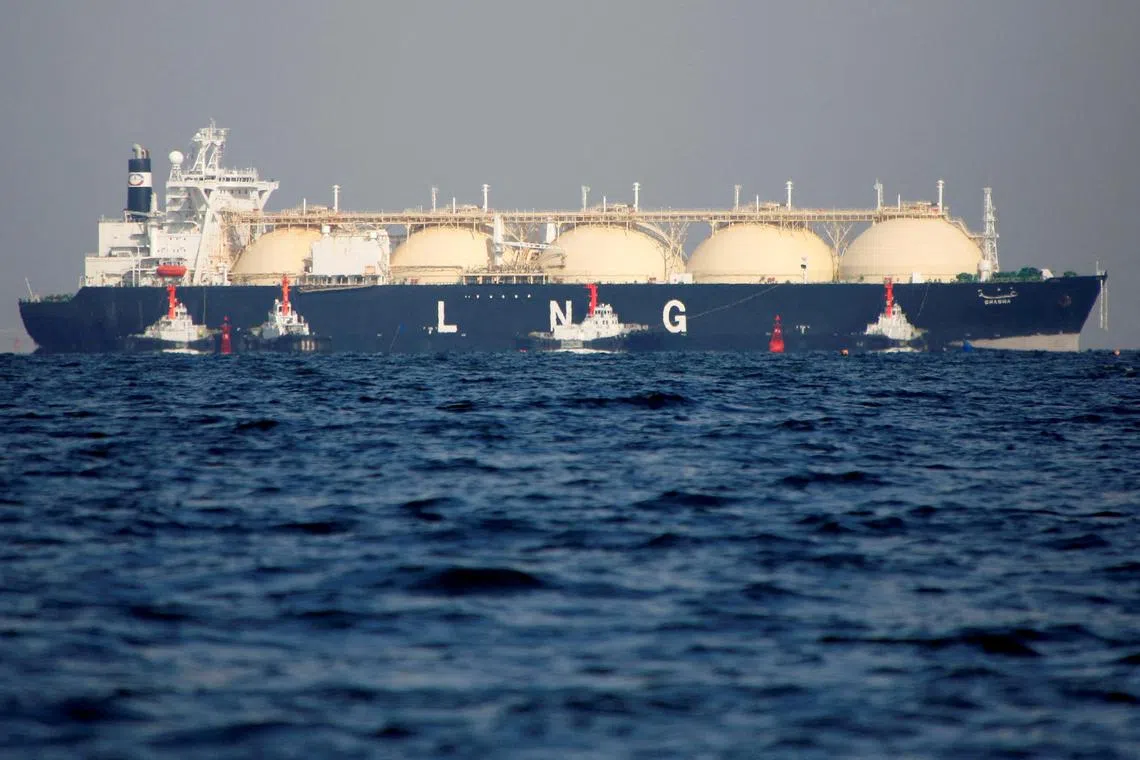As LNG investment booms, a tanker glut is on the horizon: Report
Sign up now: Get ST's newsletters delivered to your inbox

There were around 700 ships in the global LNG fleet as of the end of 2021.
PHOTO: REUTERS
Follow topic:
SINGAPORE - The world could be facing a glut of giant liquefied natural gas (LNG) tanker ships set to be built this decade even as nations shift away from fossil fuels to reach global temperature goals, a report published on Thursday said.
That could mean the tankers could become stranded assets, causing large losses for shipbuilders and shipowners hoping to cash in on a surge in new LNG production capacity coming online before 2030 and Europe’s dash for gas triggered by the war in Ukraine, the report said.
Shipbuilders in South Korea, where many LNG ships are built, could be badly hit by an expected LNG glut and waning demand for gas, said the report by Climate Analytics, a Berlin-based climate think-tank, and Solutions for Our Climate, a South Korean climate and energy advocacy group.
“To avoid the worst damage from climate change, the world is moving towards decarbonising the global economy, a transition that requires us to drastically reduce our reliance on fossil fuels over the next 10 to 20 years,” said report author, Climate Analytics analyst Victor Maxwell.
“This means the massive number of new LNG carriers the shipbuilding industry is set to deliver this decade will not be needed and are very likely to become stranded assets,” he said in a statement.
Yet, a number of nations – including Qatar, the United States, the United Arab Emirates and Australia – are building large amounts of new LNG capacity that some analysts say is not needed. Europe’s recent appetite for LNG is expected to be temporary as energy efficiency, green energy investment and the shift to electrification curb gas use on the continent.
Asia remains the top customer of LNG and the region’s share of global LNG demand is forecast to be above 60 per cent in 2023, with China and Japan being the top buyers. LNG is used mainly for power generation, heating and industry.
But long-term gas demand in Asia is also in doubt.
The International Energy Agency (IEA) said in its 2022 energy outlook that the momentum behind natural gas growth in developing economies had slowed, notably in South and South-east Asia.
There were around 700 ships in the global LNG fleet as at the end of 2021, according to Climate Analytics and Solutions for Our Climate. A further 34 LNG carriers were added in 2022 and another 335 LNG carriers are set to be delivered between 2023 and 2028.
Korean shipbuilders Hyundai Heavy Industries, Samsung Heavy Industries and Daewoo Shipbuilding and Marine Engineering have delivered the vast majority of new LNG shipping capacity to date, according to the report, which noted that Korean shipbuilders won 70 per cent of the global orders for large LNG carriers in 2022.
“The risk is imminent for Korean shipbuilders who are highly reliant on building hundreds of LNG carriers that a net-zero world will not need, and that they may not even be paid for,” said Mr Dongjae Oh, the oil and gas finance programme lead at Solutions for Our Climate.
The world needs to quickly phase out fossil fuels if global warming is to be capped at 1.5 deg C above pre-industrial levels, a key goal of the United Nations Paris climate agreement. Getting there means reaching net-zero emissions by 2050.
Fossil fuel consumption would need to fall 85 per cent from 2021 to 2050, the IEA said. Gas demand will have to decline by 55 per cent by 2050 under the IEA’s net-zero pathway.
Despite this, the report’s authors said South Korean shipbuilders are looking at a wave of new orders from oil and gas companies. For example, QatarEnergy and South Korean shipbuilders were discussing an order of up to 40 new LNG carriers for delivery in 2027, the authors said.
Cheaper renewables and rapid advances in battery storage for power grids could help shift demand away from gas, whose volatile prices have already led some customers in Asia to suspend buying LNG cargoes, analysts say.
“The world will start to shift away from oil and LNG over the next 20 years. We are seeing it already in oil demand with the increase in electric vehicle sales,” said Mr Kevin Morrison, energy finance analyst (LNG/gas), at the Institute for Energy Economics and Financial Analysis, a think-tank based in the US.
“In LNG, we are seeing a large expansion in capacity, particularly in Qatar and the US, but this comes with some risk as a significant share of the new capacity is not underpinned by long-term sales agreements. These deals have traditionally underwritten LNG projects that are often very capital intensive,” he told The Straits Times.
He said the world could be facing a global glut of new LNG supply by 2027. “The global demand for gas is uncertain as governments are implementing policies to electrify households and businesses and move away from gas,” Mr Morrison said.
The shift towards shorter duration LNG sales contracts “partially reflects that even the utilities may not be so confident of the long-term demand for gas”, he added.


